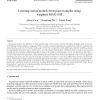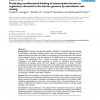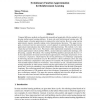1918 search results - page 375 / 384 » Discovering Cortical Algorithms |
AI
2007
Springer
13 years 7 months ago
2007
Springer
AI planning requires the definition of action models using a formal action and plan description language, such as the standard Planning Domain Definition Language (PDDL), as inp...
BMCBI
2007
13 years 7 months ago
2007
Background: Cis-acting transcriptional regulatory elements in mammalian genomes typically contain specific combinations of binding sites for various transcription factors. Althoug...
BMCBI
2007
13 years 7 months ago
2007
Background: The ambition of most molecular biologists is the understanding of the intricate network of molecular interactions that control biological systems. As scientists uncove...
BMCBI
2007
13 years 7 months ago
2007
Background: Sequence motifs representing transcription factor binding sites (TFBS) are commonly encoded as position frequency matrices (PFM) or degenerate consensus sequences (CS)...
CORR
2010
Springer
13 years 7 months ago
2010
Springer
Temporal difference methods are theoretically grounded and empirically effective methods for addressing reinforcement learning problems. In most real-world reinforcement learning ...



